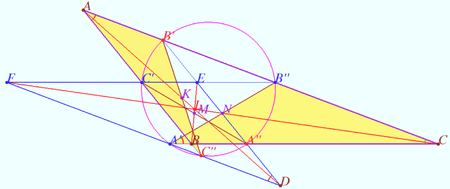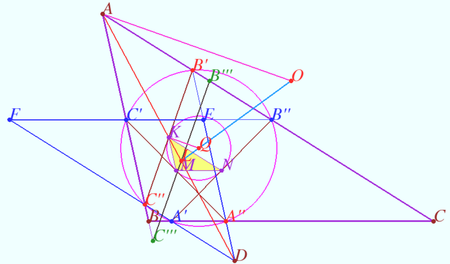Difference between revisions of "Tucker circles"
(Created page with "The Tucker circles are a generalization of the cosine circle and first Lemoine circle.") |
|||
| Line 1: | Line 1: | ||
The Tucker circles are a generalization of the cosine circle and first Lemoine circle. | The Tucker circles are a generalization of the cosine circle and first Lemoine circle. | ||
| + | ==Tucker circle== | ||
| + | [[File:Tucker circle.png|450px|right]] | ||
| + | [[File:Tucker circle A.png|450px|right]] | ||
| + | Let triangle <math>ABC</math> be given. <math>O</math> is it’s circumcenter, <math>L</math> is it’s Lemoine point. | ||
| + | |||
| + | Let homothety centered at <math>L</math> with factor <math>k</math> maps <math>\triangle ABC</math> into <math>\triangle DEF</math>. | ||
| + | |||
| + | Denote the crosspoints of sidelines these triangles as | ||
| + | <cmath>A' = BC \cap DF, B' = AC \cap DE, C' = AB \cap EF,</cmath> | ||
| + | <cmath> A'' = BC \cap DE, B'' = AC \cap EF, C'' = AB \cap DF.</cmath> | ||
| + | |||
| + | Prove that points <math>A', B', C', A'', B'',</math> and <math>C''</math> lies on the circle centered at <math>LO</math> (Tucker circle). | ||
| + | |||
| + | <i><b>Proof</b></i> | ||
| + | |||
| + | <math>AB' || C''D, AC'' || B'D \implies AB'DC''</math> is the parallelogram. | ||
| + | |||
| + | Denote <math>K = AD \cap B'C'', AK = KD, B'K = KC'' \implies</math> | ||
| + | <math>B'C''</math> is antiparallel to <math>BC.</math> | ||
| + | |||
| + | Similarly, <math>A''C'</math> is antiparallel to <math>AC, A'B''</math> is antiparallel to <math>AB.</math> | ||
| + | |||
| + | <math>M = BE \cap A''C'</math> is midpoint <math>BE, N = A'B'' \cap CF</math> is the midpoint <math>CF.</math> | ||
| + | |||
| + | <math>\triangle AB'C'' \sim \triangle ABC.</math> | ||
| + | |||
| + | <math>\frac {LD}{AL} = k, AL = LD \implies \frac {AK}{AL} = \frac{2}{k+1}, \frac {KL}{AL} = \frac{1-k}{1+k}.</math> | ||
| + | |||
| + | Similarly, <math>\frac {BM}{BL} = \frac {CN}{CL} = \frac {AK}{AL} =\frac{2}{k+1}, \frac {KL}{AL} = \frac{ML}{BM}= \frac {NL}{CL} = \frac{1-k}{1+k}.</math> | ||
| + | |||
| + | Let <math>B'''C'''</math> be the symmedian <math>BC</math> through <math>L.</math> | ||
| + | <cmath>B'''C''' || B'C'' \implies B'C'' = B'''C''' \cdot \frac {AK}{AL} =\frac{2B'''C'''}{k+1}.</cmath> | ||
| + | |||
| + | It is known that three symmedians through <math>L</math> are equal, so <math>A''C' = C''B' = B''A' = \frac{2B'''C'''}{k+1}.</math> | ||
| + | |||
| + | <math>\triangle KMN</math> is homothetic to <math>\triangle ABC</math> with center <math>L</math> and factor <math>\frac{1-k}{1+k}.</math> | ||
| + | |||
| + | So segments <math>A''C' = C''B' = B''A'</math> are tangents to <math>\odot KMN</math> and points of contact are the midpoints of these segments. | ||
| + | |||
| + | Denote <math>Q</math> the circumcenter of <math>\triangle KMN, Q \in LO.</math> | ||
| + | |||
| + | Therefore <math>A'Q = B'Q = C'Q = A''Q = B''Q = C''Q. \blacksquare</math> | ||
| + | |||
| + | '''vladimir.shelomovskii@gmail.com, vvsss''' | ||
Revision as of 05:32, 4 August 2024
The Tucker circles are a generalization of the cosine circle and first Lemoine circle.
Tucker circle
Let triangle ![]() be given.
be given. ![]() is it’s circumcenter,
is it’s circumcenter, ![]() is it’s Lemoine point.
is it’s Lemoine point.
Let homothety centered at ![]() with factor
with factor ![]() maps
maps ![]() into
into ![]() .
.
Denote the crosspoints of sidelines these triangles as
![]()
![]()
Prove that points ![]() and
and ![]() lies on the circle centered at
lies on the circle centered at ![]() (Tucker circle).
(Tucker circle).
Proof
![]() is the parallelogram.
is the parallelogram.
Denote ![]()
![]() is antiparallel to
is antiparallel to ![]()
Similarly, ![]() is antiparallel to
is antiparallel to ![]() is antiparallel to
is antiparallel to ![]()
![]() is midpoint
is midpoint ![]() is the midpoint
is the midpoint ![]()
![]()
![]()
Similarly, ![]()
Let ![]() be the symmedian
be the symmedian ![]() through
through ![]()
![]()
It is known that three symmedians through ![]() are equal, so
are equal, so ![]()
![]() is homothetic to
is homothetic to ![]() with center
with center ![]() and factor
and factor ![]()
So segments ![]() are tangents to
are tangents to ![]() and points of contact are the midpoints of these segments.
and points of contact are the midpoints of these segments.
Denote ![]() the circumcenter of
the circumcenter of ![]()
Therefore ![]()
vladimir.shelomovskii@gmail.com, vvsss











